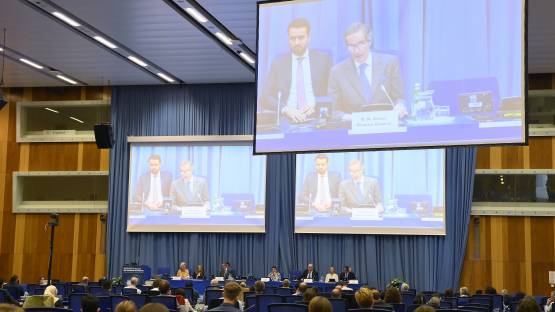Today, more than 20,000 accelerators around the world help create radiopharmaceuticals, cure diseases, preserve food, monitor the environment, strengthen materials, understand fundamental physics, study the past and even solve crimes. The IAEA, through its coordinated research projects and its technical cooperation programme, supports countries with accelerator applications in health, agriculture, research, environmental monitoring, cultural heritage and industry.
Mr Grossi explained how accelerator technology plays a critical role in two IAEA initiatives that have been launched over the last year: Rays of Hope, which is aimed at improving access to radiotherapy and cancer care in low and middle income countries; and NUTEC plastics, which supports countries in addressing plastic waste, both in the ocean and on land. Mr Grossi said that linear accelerators or ‘linacs’, can destroy cancerous tumours, and that accelerators can be used to treat plastic wastes and turn them into valuable products in support of a circular economy.
Najat Mokhtar, IAEA Deputy Director General and Head of the Department of Nuclear Sciences and Applications, emphasized the role of accelerator technology in meeting the United Nations Sustainable Development Goals — a set of 17 global targets aimed to address poverty, inequality, climate change, environmental degradation, peace and justice. Ms Mokhtar said she looked forward to discussions on how accelerator access can be increased in developing countries, to address issues such as food waste and sewage waste management.
Accelerators have a role in nuclear energy, too. Mikhail Chudakov, IAEA Deputy Director General and Head of the Department of Nuclear Energy, said accelerators are an essential component in the accelerator-driven system (ADS) concept for both energy production and nuclear waste management. ADS can transmute high level and very long-lived nuclear waste products from reactors into much shorter-lived waste — this has implications for the costs and manageability of radioactive waste, as well as the public perception of nuclear energy. Mr Chudakov also spoke on the importance of accelerators in testing the materials used in nuclear fission and fusion reactors, where ion beams techniques can simulate the radiation and damage caused by a reactor’s operation.
Hua Liu, IAEA Deputy Director General and Head of the Department of Technical Cooperation, said ion beams help address many developmental needs and explained how the IAEA supports countries with capacity building and training for using accelerators. He described the IAEA’s assistance in establishing the Synchrotron-light for Experimental Science and Applications in the Middle East (SESAME) project in Jordan, as well as IAEA cooperation at the Synchrotron Light Research Institute in Thailand. The IAEA assists countries in arranging for scientists to be trained at these facilities, as well as the Elettra Sincrotrone Trieste, in Italy, which the IAEA jointly operates. Mr Liu said the IAEA is now also helping coordinate the establishment of the synchrotron in Africa.






